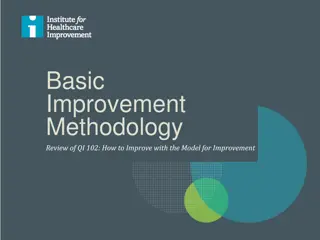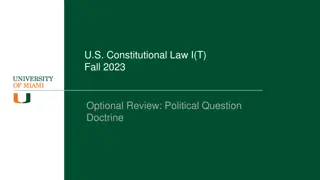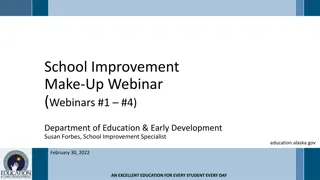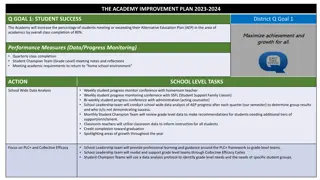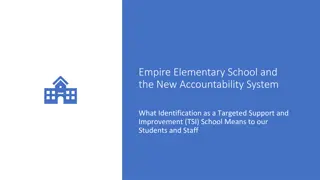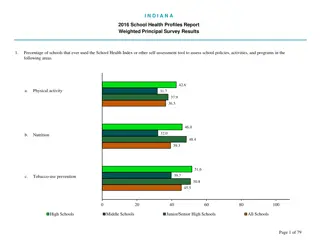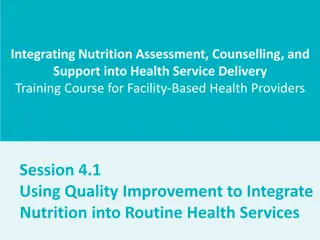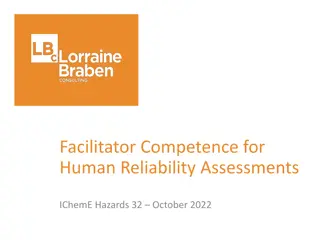Demonstrable Improvement Process Overview for 2019-20 School Years
Demonstable Improvement process for the 2018-2019 to 2020-2021 school years, focusing on the changes for 2019-20. Learn about the indicators, timelines, and resources available for schools in Superintendent Receivership Cohort 1 and Cohort 2. Gain insights into performance-based and accountability subgroup indicators, including ELA/Math Performance Indices, Graduation Rates, and more.
Download Presentation

Please find below an Image/Link to download the presentation.
The content on the website is provided AS IS for your information and personal use only. It may not be sold, licensed, or shared on other websites without obtaining consent from the author.If you encounter any issues during the download, it is possible that the publisher has removed the file from their server.
You are allowed to download the files provided on this website for personal or commercial use, subject to the condition that they are used lawfully. All files are the property of their respective owners.
The content on the website is provided AS IS for your information and personal use only. It may not be sold, licensed, or shared on other websites without obtaining consent from the author.
E N D
Presentation Transcript
Demonstrable Improvement for 2019-20 January 27, 2020 Jason Harmon Assistant Commissioner, Office of Accountability Andrew Morozov Associate in Education Research
Purpose of the Webinar 1. Provide an overview of the current system. 2. Provide a summary of the Demonstrable Improvement (DI) process for the 2018-19 to 2020-21 School Years. 3. Describe the changes to DI process for 2019-20. 4. Review the 2019-20 DI Timeline and Next Steps. 5. Identify Resources and Answer Questions. 2
Schools in Superintendent Receivership Cohort 1: Schools that were in Receivership status for the 2017-18 school year and were re- identified in the 2018-19 school year (N=14). Cohort 2: Schools that were newly identified in the 2018-19 school year (N=26). 4
DI Indicators Level 1 Mostly performance-based (e.g., ELA/Math Performance Indices, Student Growth, and Graduation Rate). Based on results for the All Students group (not subgroups). Selected by SED if school performance was below the state median in the baseline year (2017-18). Level 2 Mostly based on accountability subgroups (e.g., Students with Disabilities, racial/ethnic subgroups). Selected by the district in performance or program areas where the school s performance was below the state median in the baseline year (2017-18). Includes process indicators that measure progress based on rubric criteria. Local Districts may propose indicators that are unique to their schools as Level 1 or Level 2 indicators. 5
DI Indicators: Level 1 High Schools Elementary & Middle Schools School Safety [year] Total Cohort (11th Graders) Passing ELA Regents [year] Total Cohort (10th Graders) Passing Math Regents ELA Performance Index Math Performance Index Science Performance Index Social Studies Performance Index Chronic Absenteeism College, Career, & Civic Readiness (CCCR) Index [year] Total Cohort 4-Year Grad Rate [year] Total Cohort 5-Year Grad Rate [year] Total Cohort 6-Year Grad Rate ELP Success Ratio Student Suspension Rate (Out of School)2 School Safety 3-8 ELA All Students MGP 3-8 Math All Students MGP Chronic Absenteeism ELA Core Subject Performance Index1 Math Core Subject Performance Index1 Science Core Subject Performance Index1 ELA Weighted Academic Achievement Index1 Math Weighted Academic Achievement Index1 Science Weighted Academic Achievement Index1 ELP Success Ratio Student Suspension Rate (Out of School)2 1 Core Subject PI and Weighted Academic Achievement Index calculations use the same formula in the numerator. For the denominator, the Weighted Academic Achievement Index uses the greater of: (1) # of continuously enrolled students who are tested, or (2) 95% of continuously enrolled students. The Core Subject Performance Index denominator is the # of continuously enrolled students who are tested. 2 Indicator not used for the 2018-19 and 2019-20 school years. 6
DI Indicators: Level 2 Indicator Name Student Attendance 3-8 ELA MGP1 3-8 Math MGP1 3-8 ELA Level 2 and above Gap with non-similarly classified Students1 3-8 Math Level 2 and above Gap with non-similarly classified Students1 HS ELA Level 2 and above Gap with non-similarly classified Students1 HS Math Level 2 and above Gap with non-similarly classified Students1 [year] Total Cohort (9th Graders) with 5 or more credits [year] Total Cohort (10th Graders) with 5 or more credits [year] Total Cohort (11th Graders) with 5 or more credits [year] Total Cohort 4-Year Grad Rate1 [year] Total Cohort 5-Year Grad Rate1 [year] Total Cohort 6-Year Grad Rate1 Drop Out Rate2 Teacher Turnover Teacher Attendance HS Student Promotion Rate (promoted from grades 9,10 & 11) 3-8 ELA Core Subject Performance Index1 3-8 Math Core Subject Performance Index1 3-8 ELA Weighted Average Performance Index1 3-8 Math Weighted Average Performance Index1 HS ELA Performance Index1 HS Math Performance Index1 Science Performance Index1 Social Studies Performance Index1 College, Career, & Civic Readiness (CCCR) Index 1 Level 2 indicators are based on the accountability subgroups. 2 Indicator not used for the 2018-19 and 2019-20 school years. 7
DI Indicators: Level 2 Process indicators that measure progress based on rubric criteria. Indicator Name Plan for and implement Community School Model Provide 200 Hours of Extended Day Learning Time (ELT) Curriculum Development and Support (DTSDE Tenet 3) Teacher Practices and Decisions (DTSDE Tenet 4) Family and Community Engagement (DTSDE Tenet 6) 8
Annual Progress Targets Example: Year 1 Progress Target = 1/12th of the gap between the 2017-18 school and state baselines. Level 1 Indicator Targets (expressed as gap fractions) Year Cohorts 1 & 2 2018-19 2019-20 2020-21 1/12 2/12 = 1/6 3/12 = 1/4 Level 2 Indicator Targets Year Cohort 1 Cohort 2 2018-19 2019-20 2020-21 1/8 2/8 = 1/4 3/8 1/12 2/12 = 1/6 3/12 = 1/4 9
DI Methodology: Computing the DI Index A school makes progress on an indicator if it meets or exceeds the annual Progress Target for that indicator. No partial or extra credit will be assigned if the school does not meet the Progress Target. DI Index is a weighted average of Level 1 and Level 2 indicators for which the school met the Progress Target. Level 1 indicators comprise 50% of the DI Index and Level 2 indicators comprise 50% of the DI Index, regardless of the number of Level 1 and Level 2 indicators. Each indicator within Level 1 and Level 2 is weighted equally, with the exception of indicators #2 (Community School Model), #6-8 (DTSDE Tenets), and #94 (ELT) for Cohort 1 schools see section Changes for 2019-20 . DI Index ranges from 0% to 100%, with cutpoints as follows: >= 67% >= 40% & < 67% < 40% Preliminarily Determination: Made DI Commissioner s Decision Preliminarily Determination: Did Not Make DI 10
Demonstrable Improvement Determinations NYSED will make preliminary determinations as to whether school made Demonstrable Improvement based on the results for each indicator. For schools with a DI Index at or above 40% but below 67%, the Commissioner will review additional data to make preliminary DI determinations and may consult with district stakeholders. Districts may appeal the preliminary determinations. The Commissioner will then make final determinations as to whether the school made DI. 11
2. DI Process for the 2018-19 to 2020-21 School Years
DI Process for the 2018-19 to 2020-21 School Years Beginning with the 2018-19 school year, NYSED revised the DI methodology to: align DI indicators with the ESSA accountability indicators, update and streamline annual Progress Targets, and differentiate Targets for Cohort 1 and Cohort 2 schools. In 2018-19 Schools were assigned and asked to select new indicators based on the revised methodology. Results were provided for informational purposes only. Cohort 1 schools: DI determinations based on the revised methodology will first be made using 2019-20 school year results. Cohort 2 schools: DI determinations will first be made in the Fall of 2021 using DI Indices based on the 2019-20 and 2020- 21 school year results. 13
DI Process for the 2018-19 to 2020-21 School Years For a detailed overview of DI process, please see the January 2019 presentation Demonstrable Improvement for Schools in Receivership : http://www.p12.nysed.gov/accountability/documents/DI_Process_Jan2 019_fin.pptx 14
How a School Exits Receivership Cohort 1 and Cohort 2 Schools: Schools will be removed from Receivership at the end of the school year in which the school is not identified as a Comprehensive Support and Improvement (CSI) School. The first opportunity for removal will be as of June 2021 if a school made CSI Progress based on 2018-19 and 2019-20 school year results. The next opportunity for removal will be as of June 2022 if a school is not re-identified as CSI based on 2020-21 school year results. Making DI does not determine whether a school is placed into or removed from Receivership. Making DI determines whether a school continues under a Superintendent Receiver or is placed in Independent Receivership. 15
Implications of DI Determinations: Cohort 1 DI determinations in Fall 2020 based on 2019-20 school year results. Made DI: School continues under Superintendent Receiver. Did not Make DI: School placed in Independent Receivership. A DI Index and determination for each Cohort 1 school will be publicly released on the Receivership Dashboard in Fall 2020. Notes: If a school makes CSI Progress for 2018-19 and 2019-20 then it will be removed from Receivership as of June 2021. If a school makes CSI Progress for 2019-20 then it continues under Superintendent Receiver. 16
Implications of DI Determinations: Cohort 2 No DI determinations will be made in Fall 2020. A DI Index will be computed based on the 2019-20 school year results. A DI Index for each Cohort 2 school will be publicly released on the Receivership Dashboard in Fall 2020. 17
Implications of DI Determinations: Cohort 2 The first DI Determinations for Cohort 2 schools will be made in the Fall of 2021 using DI Indices for 2019-20 and 2020-21. Made DI: School continues under Superintendent Receiver. Did not Make DI: School placed in Independent Receivership. Notes: If a school makes CSI Progress for 2018-19 and 2019-20 then it will be removed from Receivership as of June 2021. If a school is not re-identified as CSI based on 2020-21 school year results then it will be removed from Receivership as of June 2022. 18
Summary of Changes for 2019-20 Updated Data Dictionary. Receivership Dashboard layout for Cohort 1 schools. Weighting of Level 2 Indicators #2 (Community School Model), #6-8 (DTSDE Tenets), and #94 (Extended Learning Time) for Cohort 1 schools. Updated rubrics for Indicators #2 and #94. Scoring process for DTSDE Tenet Indicators #6-8. Revised calculation methodology for Indicator #5 (School Safety). Alternative Level 1 and Level 2 Indicators. Additional Level 1 Indicators. Note on Indicator #4 (Student Suspension Rate). 20
Updated Data Dictionary Updated Data Dictionary is available on the School Receivership page: http://www.p12.nysed.gov/accountability/de/SchoolReceivership.html Additional information: Column with Indicator Level. Indicator descriptions that will be used for Demonstrable Improvement in 2019-20 and 2020-21. Updated definitions for Indicators #2 (Community School Model), #5 (School Safety), and #94 (Extended Learning Time). 21
Dashboard Layout for Cohort 1 Schools Beginning with 2019-20 school year results, the Receivership Dashboard on data.nysed.gov will only display results for the new ESSA-aligned indicators for Cohort 1 schools. These ESSA-aligned indicators were selected by schools for the 3-year Receivership cycle beginning with 2018-19. Indicators aligned to the ESEA Flexibility Waiver that were selected in 2015-16 sunset after the 2018-19 school year. These old indicators will not be displayed for Cohort 1 schools beginning with 2019-20 (see example on next slide). 22
Dashboard Layout for Cohort 1 Schools This section will no longer be displayed for Cohort 1 schools: 23
Weighting of Level 2 Indicators #2, #6-8, and #94 for Cohort 1 schools. For 2018-19, Indicators #2, #6-8, and #94 were weighted .5% each of the DI Index (1% each of the Level 2 component). Example: A Cohort 1 school has a total of 7 Level 2 indicators including indicators #2 and #94. Indicators #2 and #94 contribute .5% each to DI Index. Weights for the 5 remaining Level 2 indicators: (50% - .5% x 2) / (7-2) = 49% / 5 = 9.8% For 2019-20 and beyond, these indicators will be weighted 1% each of the DI Index. Example: A Cohort 1 school has a total of 7 Level 2 indicators including indicators #2 and #94. Indicators #2 and #94 contribute 1% each to DI Index. Weights for the 5 remaining Level 2 indicators: (50% - 1% x 2) / (7-2) = 48% / 5 = 9.6% 24
2019-20 Extended Learning Time Rubric Please use the updated rubric for 2019-20 submission available on the School Receivership page: http://www.p12.nysed.gov/accountability/de/SchoolRecei vership.html Removed checkbox option for Cohort 1 1st year since there are no schools in this category. The two options are: Cohort 1 Year 5 and Cohort 2 Year 1 (The 2018-19 school year was not counted as Year 1 for Cohort 2 schools). 25
2019-20 Community Schools Rubric Please use the updated rubric for 2019-20 submission available on the School Receivership page: http://www.p12.nysed.gov/accountability/de/SchoolReceivership.html Removed checkbox option for Cohort 1 1styear since there are no schools in this category. Corrected the number of items (seven) that make up the CS criteria in the Commissioner s Regulations. Note: Due to the transition, OA will not require Cohort 2 schools to reach full implementation of the CS model by the end of the current Receivership cycle (the 2018-19 to 2020-21 school years). Therefore, the 2019-20 school year will be treated as Year 1 and the 2020-21 school year as Year 2 when applying the rubric criteria. New York s Community Schools Technical Assistance Centers provide resources and technical assistance to schools and districts. Find your regional center here. 26
Scoring process for DTSDE indicators For 2018-19, Indicators #6-8 (DTSDE Tenets) were scored using a self-evaluation process whereby schools identified which of the indicators in the DTSDE Phases of Implementation for that Tenet were in place, and done consistently and with good quality. For 2019-20 and 2020-21, these indicators will be assessed by the NYSED Field Support unit, which will visit schools in May and June. Schools that have selected a DTSDE indicator should continually review these indicators for Phases 1, 2, and 3 for that Tenet and collect supporting evidence of the specific items being in place, and being done consistently and with good quality. 27
Calculation of Indicator #5 (School Safety) The School Violence Index (SVI) computation methodology was revised beginning with 2018-19 school year results (see next slide). The change is related to the reporting of Dignity for All Students Act (DASA) incidents for programmatic purposes. The revised SVI definition was used for schools that were assigned this Level 1 indicator under the ESSA-aligned system. 28
Calculation of Indicator #5 (School Safety) The following categories on the School Safety and the Educational Climate (SSEC) Summary Data Collection Form were removed from the numerator when computing the SVI: #5a - Material Incidents of Discrimination, Harassment, and Bullying (Except Cyberbullying) #5b Cyberbullying Old Weight 100 60 40 45 30 New Weight 100 60 40 45 30 Incident Category Homicide Forcible Sex Offenses Other Sex Offenses Assault: Serious Physical Injury Assault: Physical Injury 1 1 Weapons Possession: Routine Security Check 15 15 Weapons Possession: Other Material Incidents of Discrimination, Harassment, and Bullying (all excluding Cyberbullying) 1 n/a 1 n/a Cyberbullying 29
Alternative Level 1 and Level 2 Indicators Schools serving either Elementary-Middle (EM) or High School (HS) grade levels must have a minimum of five Level 1 and five Level 2 DI indicators. Schools serving both EM and HS grades must have a minimum of seven Level 1 and seven Level 2 indicators. Districts where suppression of indicators due to an insufficient number of records caused a school to fall below the minimum number of required indicators were required to select alternative indicators from a list provided by NYSED. Progress Targets for the 2019-20 and 2020-21 school years were determined for alternative indicators using 2018-19 school year results as the baseline year. 30
Alternative Level 1 and Level 2 Indicators Alternative indicators supplement (not supplant) the previously suppressed indicators. If a 2019-20 school year result is computed for a previously suppressed indicator and the alternative indicator, both indicators will be used to compute the DI Index. If the previously suppressed indicator is also suppressed for 2019-20 school year results but the alternative indicator is not, the alternative indicator will be used in place of the previously suppressed indicator. 31
Additional Level 1 Indicators The 2018-19 school year results using the new ESSA-aligned indicators were provided for informational purposes only. 2019-20 school year is treated as Year 1 for DI purposes. No additional Level 1 indicators will be assigned for this year. If a Level 1 indicator result for 2019-20 school year falls below the 2019-20 school year state baseline, that indicator may be assigned to the school as an additional Level 1 indicator for the 2020-21 school year. 32
Indicator #4 (Student Suspension Rate) No change from 2018-19: Indicator #4 (Student Suspension Rate) will not be used for the 2019-20 school year. As part of its ESSA plan, the Department is developing an out-of-school suspension measure. This information will be provided to schools later this school year. The 2019-20 school year results may be used as a baseline to set targets for purposes of 2020-21 school year DI determinations. 33
2019-20 DI Timeline July-August 2020: Districts submit the data for their indicators via SIRS and/or IDEx (similar to 2018-19). August graduates are submitted via the IRS Data Exchange (IDEx) for indicators #70-75 (Total Cohort 4-Year Grad Rate), #88-93 (Total Cohort 5-Year Grad Rate), and #250-255 (Total Cohort 6-Year Grad Rate). Rubrics for indicators #2 (CS) and #94 (ELT), as well as outcomes for Local indicators, are submitted via email. Early September 2020: NYSED will provide to districts the preliminary DI outcomes for data appeals. Late September early October 2020: NYSED will provide to districts the preliminary DI determinations for Cohort 1 schools and DI Indices for Cohort 2 schools. DI determinations for Cohort 2 schools will not be made until the Fall of 2021 using DI Indices for 2019-20 and 2020-21 (see slides 16-18). Results will be shared via a secure release on the Receivership dashboard (similar to 2018-19). Late October - early November 2020: Districts and stakeholders will be informed of the final Demonstrable Improvement status for Cohort 1 schools and/or the final DI Indices for Cohort 2 schools. The Department will also publicly release the Receivership dashboard. 35
2019-20 Next Steps Districts that were provided with alternative indicators were required to submit their selections by January 21, 2020. NYSED will send districts letters that will include final lists of 2019-20 DI Indicators and Progress Targets on or around January 31. NYSED will send notification later in the spring with additional guidance on data submission. 36
Resources Office of Accountability: http://www.p12.nysed.gov/accountability/de/SchoolReceiver ship.html Data Dictionary for 2018-19 to 2020-21 Community School Model Rubric - 2019-20 Extended Learning Time Rubric - 2019-20 Office of Innovation and School Reform: http://www.p12.nysed.gov/oisr/ FAQ Community Schools Technical Assistance Centers: Provide resources and technical assistance to schools and districts, sharing effective and promising practices in the establishment and ongoing management of Community School strategies. Find your regional center here: https://www.nyscommunityschools.org/regions-we-serve/ 38
Questions? Submit questions to: accountinfo@nysed.gov 39




